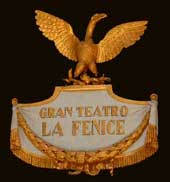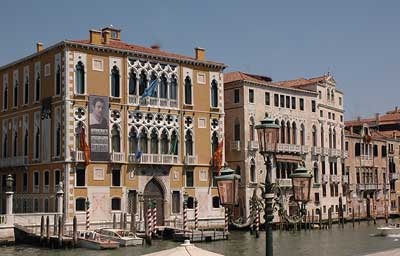ITALY / SWITZERLAND / FRANCE TRIP - 2007
In the winter of 2007, we faced a dilemma - We wanted to get back to Italy for it had been a year and a half since we had been there. But something said that we should try some place new and different. After a brief mental wrestling, we came to a compromise. We would start in Venice, then travel to Switzerland to see friends and after that branch out and explore Provence and the Cote d'Azur.
Part One
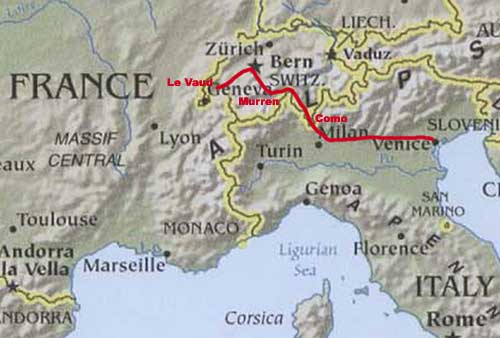
With the kids (i.e. our cats) and the B&B well cared for by Alan and Elise Hogan, we took off on April 26th, flying through Toronto and Zurich before settling into our small and favoured hotel, Albergo Doni, in the afternoon of the 27th. As we have mentioned before, this family run hotel is on a side canal near S.Zaccaria boat station on the lagoon and only a few minutes off of the Piazza San Marco. Not fancy or upscale, its simple style and location have sold us on it in past visits.
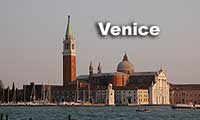
- for three nights 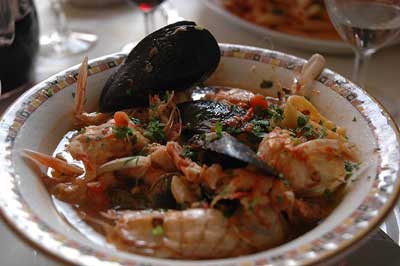
"The familiar" was our agenda for the evening so we wandered (it's the only way get around Venice's lanes and alleys) over to a favourite outdoor restaurant, Trattoria da Gianni, on Strada Nuova in Cannaregio for supper. Remembering the fish soup loaded ![]() with chunks of fish and prawns from last time, George ordered it after a tomato and buffalo salad drizzled with fresh olive oil and downed with a litre of wine and one of 'acqua con gaz.' Tana, meanwhile, had a pasta with fresh vegetables from the Veneto. We topped the evening with two gelatos from a familiar shop on S. Salizzada San Lio.
with chunks of fish and prawns from last time, George ordered it after a tomato and buffalo salad drizzled with fresh olive oil and downed with a litre of wine and one of 'acqua con gaz.' Tana, meanwhile, had a pasta with fresh vegetables from the Veneto. We topped the evening with two gelatos from a familiar shop on S. Salizzada San Lio.
The next morning was bright and warm, trending to hot by noon. Venice was crowded for, as we soon learned, it was a long weekend for the Italians (May Day) and everyone it seemed had come to Venice. After breakfast, we scurried through and away from the crowds towards La Fenice, the opera house. Built in 1789, access to the theatre was primarily by water via gondolas at that time. Now it is surrounded by pavement which proved to be a problem when it caught on fire in 1836. After the fire, La Fenice was swiftly rebuilt, proving a "magnificent, elegant work, perfect in every part". However, on 29th January 1996 another devastating and malicious fire destroyed the theatre, temporarily closed for renovation work. The fire brigade fought the blaze for the entire night but most of the theatre was ruined. In following years, Le Fenice was rebuilt, inspired by the motto: “the way it was, where it was."
Having just read "The City of Falling Angels," which details the conspiracies, politics and humourous infighting surrounding the fire and reconstruction, La Fenice was a priority for the day. The book, a 'must' for fans of Venice was written by John Berendt, the author of "Midnight in the Garden of Good and Evil," who lived on and off in Venice for many years after the 1996 fire. We had tried to get tickets to La Traviata which was playing but everything had sold out months earlier so we satisfied ourselves with a tour of the theatre.
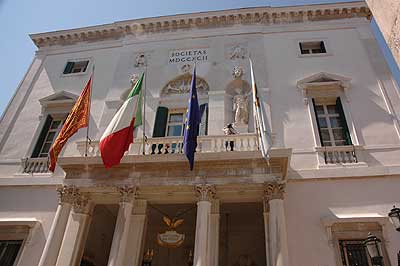 |
 |
The exterior of La Fenice |
Escaping the masses became our sole intent after the theatre as we headed west, over the Accademia bridge into Dorsoduro and to the Canale Della Giudecca
where we found a restaurant, Ristorante Sole Luna, on the Fondamenta for lunch - black spaghetti with cuttlefish for George and gnocchi with a pesto and cheese for Tana. And, being our anniversary, we washed it down with a chilled bottle of Prosecco.
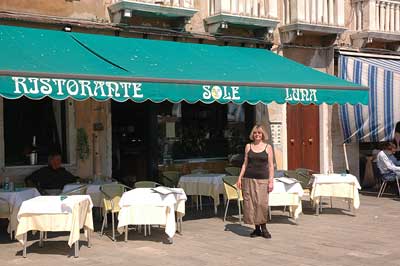 |
 |
Ristorante Sole Luna |
Feeling hot and lazy, we strolled the Fondamenta considering the possibility that we might stay there the next time we visit; neither expensive nor crowded yet within walking distance of the Piazza San Marco. (Pensione La Calcina and Pensione Seguso
Buskers abound in Venice and only the best survive. One was this fellow playing water glasses. A Russian by birth, he was making a living playing in Venice and living in Mestre, north of the city.
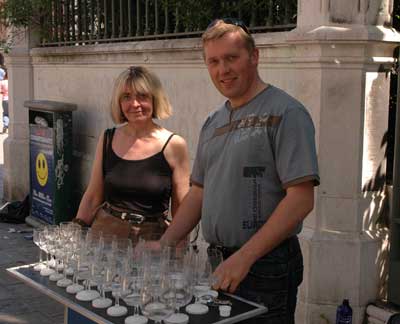 |
|
| For fans of City of Falling Angels, Palazzo Barbaro is on the right |
After a rest, it was off to the Strada Nuova for a dinner of Soar (marinated sardines in oil with onions) and cuttlefish with polenta a la Veneto for G. and assorted vegetables and spaghetti with tomato for T. Having waited on tables at the same restaurant for over 40 years, our waiter, whom we had come to know in past visits is retiring this summer, so we toasted him with Grappa after the meal and said our goodbyes.
We had planned to go to mass at the Basilica on Sunday morning but we slept in, missed breakfast and mass. With plans in disarray, we headed back to Dorsodura for lunch and then meandered to S. Maria d. Salute on the point with views across the Canal Grande before realizing that we didn't know what we were doing. Flexibility in plans is good but is best when coupled with some forethought or planning, a lesson that became very clear when we could not find a restaurant for supper. All were crowded or unappealing. We ended up in one where the enjoyment of the food (the Bigoli was probably good) was drowned out by the loud voices of a tour group next to our table.
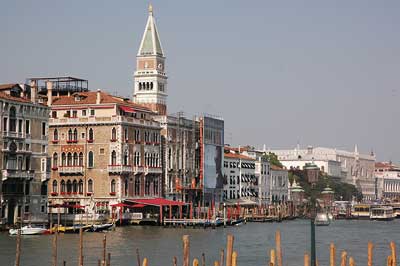 |
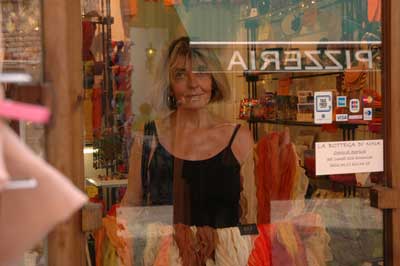 |

Early Monday morning, we took the vaporetto up the Canal Grande to Piazella Roma where we had arranged to pick up a car. We had reserved an 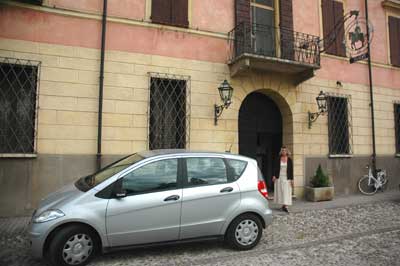 economy car but as fate would have it, they only had a Mercedes Type A diesel - great on mileage and fun to drive.
economy car but as fate would have it, they only had a Mercedes Type A diesel - great on mileage and fun to drive.
Once out of Venice, we drove west on the A4 Autostrada to Bergamo (300k) and then wound our way through the coutryside to Como on the western tip of the south end of Lago di Como. We had reserved a room in In Riva al Lago, in the city centre only a block from the lake. At first it was hard to find since the street is only 50m long and the local police Tana spoke to didn't even know its name but once found, the room was clean and safe and only 50 Euro. We can imagine that the area, and hence the room, can be quiet noisey on hot summer nights but for us it was just right.
In Piazza Cavour we enjoyed a panini and beer before wandering the town. The Duomo or cathedral with its stunning gothic façade was begun in the 14th Century. With the 18th-century dome above, it is considered to be one of the best examples of the transitional architectural style. In contrast but still viewed as a important sight is the Case del Fascio a building that is supposedly "internationally recognised as the most important modern work in Italy." It served as Mussolini's Fascist Headquarters for the region and ironically is now the headquarters of the Guardia di Finanza, a special Italian police force at the service of the Ministry of the Economy and Finance. Mussolini had passed through Como on his escape towards Switzerland at the end of World War II, before being taken prisoner and shot by Comaschi (i.e. residents of Como) partisans in a small town on the north shores of Lake Como..
 |
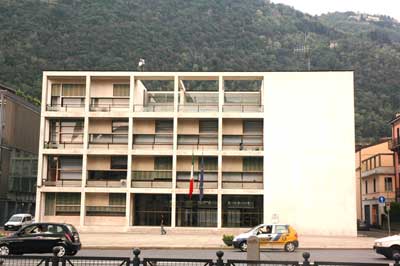 |
After a short rest, we began to search out a restaurant. Strangely the town that had been busy at lunch time was empty as visitors had headed home at the end of the holiday. Restaurants were quiet or closed so we checked every posted menu twice, finally settling on one that offered wild boar, hare pasta and a delicious rissoto for Tana. 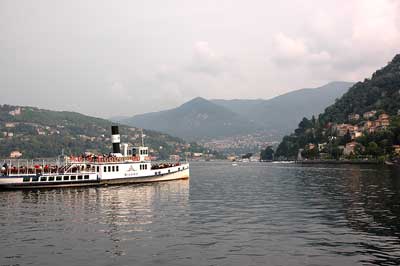 Albergo Ristorante Posta-Loto was another building proud of its design by the modernist and fascist architect who had built the headquarters. Settled in and with a bottle of local Lombardia wine ordered, we discovered that the menu was out of date; no boar, no hare, no risotto. But the waiters (we had several due to the lack of customers) worked hard and found excellent substitutes: seafood pasta for G and a tortellini with spicey tomatoes for T.
Albergo Ristorante Posta-Loto was another building proud of its design by the modernist and fascist architect who had built the headquarters. Settled in and with a bottle of local Lombardia wine ordered, we discovered that the menu was out of date; no boar, no hare, no risotto. But the waiters (we had several due to the lack of customers) worked hard and found excellent substitutes: seafood pasta for G and a tortellini with spicey tomatoes for T.
Tuesday the sun was shining again and we sought out a pastry and espresso in the piazza. ![]() While walking through the park on the lakefront, we came upon large slabs of marble and granite engraved with words, translated into six languages, of witnesses and those who were killed during the war - the Memorial to the European Resistance. The sombre and inspiring inscriptions included:
While walking through the park on the lakefront, we came upon large slabs of marble and granite engraved with words, translated into six languages, of witnesses and those who were killed during the war - the Memorial to the European Resistance. The sombre and inspiring inscriptions included:
 |
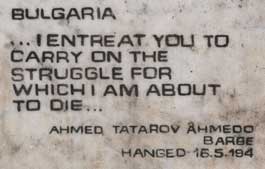 |
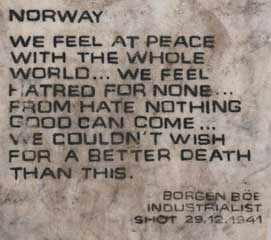 |
 |
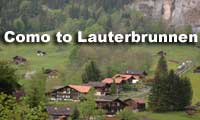
From Italy to Switzerland
We left Como around noon and drove halfway up the western side of the lake to Menaggio, a small resort town for lunch.
After lunch and shopping, we headed over the hills to Lugano in Switzerland and north through the Alps and St Gotthard tunnel. Tana's first impression of Switzerland was that of disappointment at the modern drab architecture. But once through the 17 km long tunnel into German Switzerland with its manicured alpine fields, cows with their bells and rustic chalets, her mood picked up. The pass to Interlaken was still closed due to snow so we had to detour via Luzern to get to Interlaken and eventually to Lauterbrunnen.
Ever since we met, Tana has heard about Murren, a small village perched several thousand feet above the valley floor, 1,650 m above sea level and devoid of most motorized vehicles. It was the principal filming location for the James Bond movie On Her Majesty's Secret Service. George has been there many time, always enjoying the peace and quiet and the chance to walk and hike the mountains but it was Tana's first.
Rather than take the cable car that evening as we were unsure that any hotel would be open in Murren since May is the off-season month between skiing and hiking, we decided to stay at Hotel Staubbach in the valley at Lauterbrunnen.
The town was quiet so we had a simple choice for dinner from the only two restaurants that were open. Our choice was Hotel Silberhorn for an excellent dinner of veal with rosti (G) and medallions of cheese with fresh salad (T) and a good bottle of Sardinian wine (we tried a Swiss white but it was far too light)
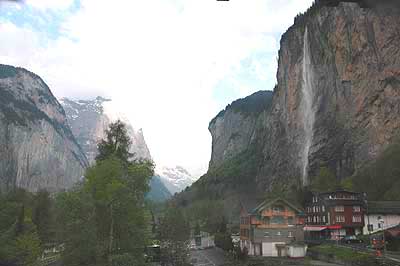 |
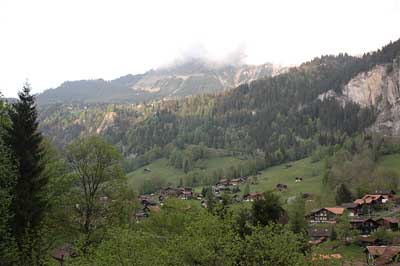 |
| The Lauterbrunnen valley provided the pictorial model for J.R.R. Tolkien's sketches and watercolors of fictitious valley of Rivendell |
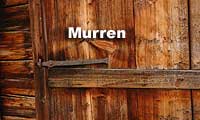
Lauterbrunnen - Murren - Le Vaud
After a hearty breakfast in the hotel we wandered through the local cemetery before taking the local bus to Stechelberg and the cable car up to Murren. The tombstones reflected the peaceful and strong lives of the earlier inhabitants.
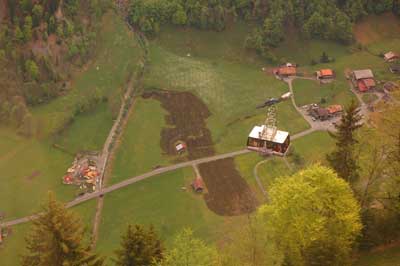 |
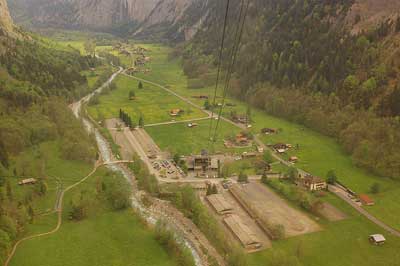 |
Murren was as George remembered from 20 years ago except for a few new chalets and a small construction van that rattled along the roads. It was very quiet. Many shops were closed but Alpenruh was open for a good lunch, of raclette and goulash, with view of "the three sisters" (the three peaks opposite) – Eiger, Mönch, and Jungfrau.
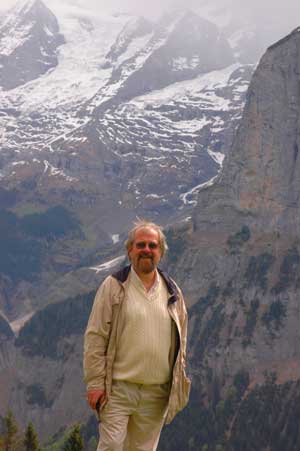

We took the alternative train, the Bergbahn Lauterbrunnen-Mürren, which consists of a narrow gauge railway along the edge of the cliff and the new cable car down into Lauterbrunnen (the 110 year old cable car has been removed because of small shifts in the cliff face each year.)
Then the drive via Bern to Jacque and Nicole Dumont, (our friends from Victoria who moved back to Switzerland a few years ago) to Le Vaud in the hills above Nyon on the north shores of Lake Geneva between Lausanne and Geneva.
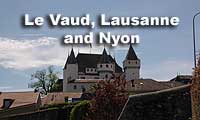
Thursday we drove into Lausanne and then Nyon with Jacque and Nicole. Despite its history, Lausanne struck us as a rather dull city. The cathedral had been cleared of its icons, decorations and details during the Reformation which swept Switzerland, leaving a rather drab and grey building. The storico centro is small and a mix of old and modern.
Nyon was a more pleasant town (perhaps because it was a town) with a grand view of Mont Blanc on the French side of Lake Geneva.
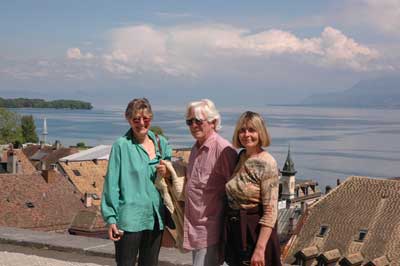 |
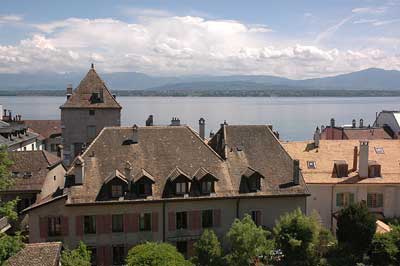 |
| Skyline of Nyon, Lac Geneva and French Alps |
